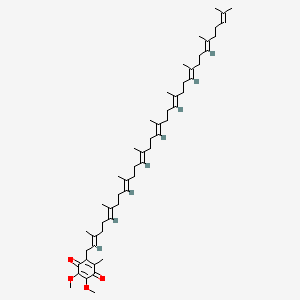| Authors | Title | Published | Journal | PubMed Link |
|---|---|---|---|---|
| Nishi K et al. | Hypothermia reduces resuscitation fluid volumes required to maintain blood pressure in a rat hemorrhagic shock model. | 2012 | J Trauma Acute Care Surg | pmid:21768895 |
| Vasta V et al. | Altered redox status of coenzyme Q9 reflects mitochondrial electron transport chain deficiencies in Caenorhabditis elegans. | 2011 | Mitochondrion | pmid:20849980 |
| Venegas C et al. | Determination of coenzyme Q10, coenzyme Q9, and melatonin contents in virgin argan oils: comparison with other edible vegetable oils. | 2011 | J. Agric. Food Chem. | pmid:22007968 |
| Parrado-Fernández C et al. | Calorie restriction modifies ubiquinone and COQ transcript levels in mouse tissues. | 2011 | Free Radic. Biol. Med. | pmid:21447381 |
| Bauerova K et al. | Combined methotrexate and coenzyme Qâ‚â‚€ therapy in adjuvant-induced arthritis evaluated using parameters of inflammation and oxidative stress. | 2010 | Acta Biochim. Pol. | pmid:20827446 |
| Kohli R et al. | High-fructose, medium chain trans fat diet induces liver fibrosis and elevates plasma coenzyme Q9 in a novel murine model of obesity and nonalcoholic steatohepatitis. | 2010 | Hepatology | pmid:20607689 |
| Bebrevska L et al. | In vivo antioxidative activity of a quantified Pueraria lobata root extract. | 2010 | J Ethnopharmacol | pmid:19799984 |
| Yoshida Y et al. | The role of alpha-tocopherol in motor hypofunction with aging in alpha-tocopherol transfer protein knockout mice as assessed by oxidative stress biomarkers. | 2010 | J. Nutr. Biochem. | pmid:19157826 |
| Sumien N et al. | Prolonged intake of coenzyme Q10 impairs cognitive functions in mice. | 2009 | J. Nutr. | pmid:19710165 |
| Cano A et al. | Hepatic VLDL assembly is disturbed in a rat model of nonalcoholic fatty liver disease: is there a role for dietary coenzyme Q? | 2009 | J. Appl. Physiol. | pmid:19608932 |
Coenzyme Q9
Coenzyme q9 is a lipid of Prenol Lipids (PR) class. The involved functions are known as Diastasis, Phosphorylation and Cardiac function.
Cross Reference
Introduction
To understand associated biological information of Coenzyme Q9, we collected biological information of abnormalities, associated pathways, cellular/molecular locations, biological functions, related genes/proteins, lipids and common seen animal/experimental models with organized paragraphs from literatures.
What diseases are associated with Coenzyme Q9?
There are no associated biomedical information in the current reference collection.
No disease MeSH terms mapped to the current reference collection.
PubChem Associated disorders and diseases
What pathways are associated with Coenzyme Q9
There are no associated biomedical information in the current reference collection.
PubChem Biomolecular Interactions and Pathways
Link to PubChem Biomolecular Interactions and PathwaysWhat cellular locations are associated with Coenzyme Q9?
There are no associated biomedical information in the current reference collection.
What functions are associated with Coenzyme Q9?
Related references are published most in these journals:
| Function | Cross reference | Weighted score | Related literatures |
|---|
What lipids are associated with Coenzyme Q9?
There are no associated biomedical information in the current reference collection.
What genes are associated with Coenzyme Q9?
There are no associated biomedical information in the current reference collection.
What common seen animal models are associated with Coenzyme Q9?
There are no associated biomedical information in the current reference collection.
